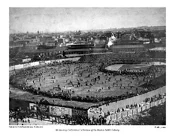Huntington Avenue American League Base Ball Grounds is the full name of a baseball stadium that formerly stood in Boston, Massachusetts and was home to the Boston Red Sox (known then as the 'Boston Americans' until 1908) from 1901-1911. The stadium, built for $35,000, was located across the New York, New Haven and Hartford Railroad tracks from the South End Grounds, home of the Boston Braves.
The stadium was the site of the first World Series game between the modern American and National leagues in 1903, and also saw the first perfect game in the modern era, thrown by Cy Young on May 5, 1904. The playing field was built on a former circus lot and was fairly large by modern standards-530 feet to center field, later expanded to 635 feet in 1908. It had many quirks not seen in modern baseball stadiums, including patches of sand in the outfield where grass would not grow, and a tool shed in deep center field that was actually in play.
The Huntington Avenue Grounds was demolished after the Red Sox left at the beginning of the 1912 season to play at Fenway Park. Solomon Court at Cabot Center, an indoor athletic venue belonging to Northeastern University, now stands on Huntington Grounds footprint. A plaque and a statue of Cy Young was erected in 1993 where the pitchers mound and home plate used to be, commemorating the history of this ballpark in what is now called World Series Way. Meanwhile, a plaque on the side of the Cabot Center (1956) marks the former location of the left field foul pole. Also, The World Series Exhibit Room in Cabot Physical Education Center is devoted to mementos of the 1901-1911 Red Sox era.
References[]

The grounds during a game. Note building from which the famous 1903 "bird's-eye" photo was taken (see box above for the picture).
- Ballpark Digest Article on Huntington Avenue Baseball Grounds
- Huntington Avenue Baseball Grounds at Baseball Almanac
- Info at Ballparks.com
| Preceded by: first stadium |
Home of the Boston Red Sox 1901-1911 |
Followed by: Fenway Park 1912-current |
